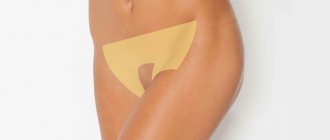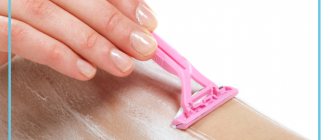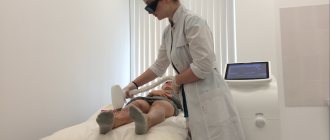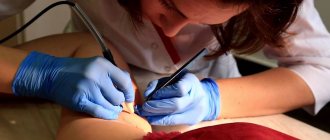From this article you will learn:
- What is laser hair removal
- What types of lasers are used in epilation to remove hair?
- Laser hair removal on the face: stages and nuances of the procedure
- Basics and subtleties of laser hair removal on legs
- Frequently asked questions about laser hair removal
Laser hair removal is a modern method in cosmetology. The use of laser is effective because it contributes to the complete destruction of hair follicles.
Thanks to this procedure, many women received an excellent opportunity to say goodbye to hair in one or another part of the body forever, moreover, the whole process goes quite quickly and, importantly, painlessly. We will tell you more about laser hair removal below.
What is laser hair removal
Laser hair removal is a cosmetic procedure that is carried out using a special device: its beam targets the coloring pigment - melanin. The laser penetrates the hair follicle and destroys its structure from the inside, thus preventing future hair growth. This procedure is most effective on dark-colored hair.
After the first session, you will not get perfectly smooth skin, but the results will still be noticeable. Thin and soft hairs will disappear without a trace, while hard hairs will become less noticeable. Remember that to achieve maximum effect, it is recommended to conduct several sessions, since laser hair removal is a course procedure. This is primarily due to the characteristics and stages of hair development, as well as the affected area. Only a specialist can determine the exact amount. As a rule, this is from 3 to 8 sessions.
Recommended articles on the topic:
- Laser stretch mark removal in a beauty salon: pros and cons of the procedure
- Thermal detoxification: lightness of the body and clear skin
- Laser scar resurfacing is a modern way to get rid of skin imperfections
The service for removing unwanted hair using a laser is provided by most beauty salons, and signing up for them is not difficult. The main thing is to make sure there are no contraindications.
How to reduce skin irritation after hair removal?
After hair removal, every girl dreams of perfectly smooth skin. To avoid the appearance of redness and itching, you need to follow simple rules before and after the procedure.
Recommendations:
- Light scrubbing of the dermis. For girls with sensitive skin, it is better to carry out the procedure immediately before hair removal. Others can do it the day before going to the cosmetologist. For scrubbing, it is better to use natural products: coffee, honey, cinnamon, ground peanuts, etc. This will reduce the risk of allergic reactions.
- Steaming the skin. A hot shower will help. Warm water helps open pores, allowing hair follicles to pass through easier and faster.
- Treating the skin with antiseptic agents. This could be Miramistin, hydrogen peroxide, or Chlorhexidine. The use of alcohol-containing products is not advisable.
- Anesthesia. When performing photo or laser hair removal, a cosmetologist can apply a lidocaine-based cream to the dermis.
During epilation, the upper layer of the dermis is injured, so the skin needs special care after epilation. Moisturizers are actively used.
If the irritation is severe, swelling or severe itching appears, you cannot do without antiseptics.
Restrictions:
- taking a bath (if possible, abstain for up to 12 hours);
- visit to the swimming pool, sauna, bathhouse (2-3 days);
- tanning (2-3 days);
- scrubbing the skin and using alcohol-based products (1-2 days);
- cosmetic procedures on the epilated area (up to a month).
Your main task after hair removal is to give your skin rest. Try not to wear synthetic, tight-fitting clothes if hair has been removed from your legs. Also forget about wearing tights and stockings for a couple of days.
Having epilated the bikini area, replace tight, constricting underwear with loose cotton sets.
After epilation, pay special attention to your facial skin. Try to go without makeup for a week. This can not only lead to severe irritation, but also cause clogged pores and the appearance of acne.
What types of lasers are used in epilation to remove hair?
Several types of laser can be used for hair removal.
- The ruby laser is very effective for fair skin and dark hair color. Its beam penetrates shallowly under the skin. During the process of thermal exposure, unwanted vegetation is eliminated in approximately 5 sessions.
- The Alexandrite laser is considered one of the most effective devices. It is used in a large number of salons, as its effectiveness is quite high. If the procedure is carried out according to all the rules, then there is no pain and complications are practically excluded.
- The peculiarity of the diode laser is that it is able to penetrate into the deep layers of the epithelium, thereby achieving maximum effect. However, the procedure takes longer. Effective when working with any type of hair.
- A neodymium laser allows you to achieve the most lasting and long-lasting (up to 5 years) hair removal effect. Its main distinguishing feature is that the action of the beam is directed directly at the hair follicle and the vessel that nourishes it.
Laser hair removal on the face: stages and nuances of the procedure
Laser hair removal will help get rid of hair on the chin, cheeks or upper lip. They not only make women feel uncomfortable, but can even lower their self-esteem.
Especially considering the fact that it is currently important to grow hair on the head and get rid of it in all other places by any available means. Hair on a woman’s face does not look aesthetically pleasing and spoils even the most attractive appearance. Therefore, in pursuit of beauty, women strive to get rid of unnecessary hair. One of the most effective methods is laser hair removal.
There are, of course, other options. This includes shaving, waxing, sugaring and plucking, and depilatory creams. The options mentioned are the simplest and most tested, but, alas, their results do not last long, and there are also restrictions on use on the skin of the face.
Effect duration
Facial hair grows very quickly (remember men, many of whom are forced to shave every day), and it is necessary to constantly fight for smooth skin. Women have to pluck regrown eyebrow hairs almost every day, and newly epilated mustaches become visible again within a few days after the procedure.
Unlike waxing, shaving, and depilatory creams, which have side effects (ingrown hairs, infections, irritation), laser hair removal has proven to be the most effective and safe method of facial hair removal. All of the above methods of getting rid of unwanted hair have a short-lived effect, while laser hair removal allows you to forget about the problem once and for all, provided you complete a course of procedures.
06/04/2006 Re-growth of hair after the first procedure
I shaved my armpits a couple of days ago and need to shave again. The hair is certainly growing, but it is still a little thinner than usual.
I didn't have any ingrown hairs the entire time after treatment. I usually have 2 – 3 small, ingrown hairs under my arms and 1 – 5 in my bikini area. I currently have large ingrown hairs in my bikini area. It looks like there are only big hairs in the bikini area that have grown in forever. The ingrown hairs that I had before the first procedure have only now started to go away. I'm not sure, but I think the treatment made the ingrown hairs shorter because the hairs don't continue to grow because they have a harder time breaking through the skin.
When I shaved my bikini area this morning, it looked as if the hair had been waxed several weeks ago, some of the hair was long, some of the hair was short. My hair has become thinner, but still as black as before the first laser treatment. Shaving became a little easier, just like after weeks of waxing. I'm guessing my hair will grow back much like before until my next laser hair removal treatment later this month.
My upper lip looks almost the same as it did before the first laser treatment. The hair is a little less black, but there is still quite a bit of long black hair, as well as a lot of blonde hair. The only thing that disappoints me about laser hair removal is that the laser had no effect on blonde hair.
Several black hairs appeared around the nipples on the chest, just like before the treatment.
Minimal impact on skin
The skin of the face is thinner and more delicate than other areas of the body, so methods that are good, for example, for removing hair on the legs, are not suitable for epilating the face. Especially if the skin is prone to irritation and rashes or is simply sensitive. Thus, it is not recommended to use an electric epilator on your face. And most depilatory creams contain harsh chemicals that cause irritation.
Waxing is often practiced to remove facial hair. This method is quite capable of making the skin smooth for one or two weeks, but it has negative sides. Firstly, the procedure is painful, and secondly, the effect of ingrown hair may occur, pinpoint redness and pustular inflammation at the site of hair removal are possible.
Laser hair removal rids the facial skin not only of hair, but also of the troubles that accompany its removal. After all, the effect on the skin is short-term (milliseconds), non-traumatic (the laser destroys the hair structure without affecting the surrounding tissues) and practically does not cause pain or discomfort.
Despite all its advantages and effectiveness, this procedure still has a number of limitations:
- diabetes;
- herpes or other infectious processes in the body;
- oncological diseases;
- the period of bearing a child or breastfeeding;
- exacerbation of allergies;
- abrasions or cuts at the site of intended impact;
- moles on the face;
- tendency to form keloid scars;
- respiratory or viral diseases;
- age up to 18 years.
The procedure is divided into several stages, each of which is carried out by a doctor in a clinic or beauty salon. In order for everything to be successful, preparation for laser hair removal must be done correctly. This issue must be taken very seriously to avoid complications. Consultation with a dermatologist is required (you need to find out about your personal tolerance to the procedure, based on skin and hair color).
After making sure that there are no contraindications, you need to start preparing for it about a week before the procedure. Laser hair removal will be more effective if you adhere to the following recommendations:
- Before exposure to an energy beam, it is recommended to test for possible allergic reactions;
- do not sunbathe;
- 1–2 days before the procedure, adjust the hair length on the desired area of the skin (use a razor for this);
- Do not apply cosmetics to your face on the day of the procedure.
Before hair removal, the doctor who will perform it must examine the client, paying special attention to the skin, and discuss possible risks and contraindications. If there are no obstacles, the procedure proceeds in the following order:
- The specialist examines the skin, determines the phototype, hair structure and adjusts the equipment: the optimal length and laser power.
- During laser hair removal, the client lies on a comfortable couch. His eyes and the doctor's eyes are protected by special glasses.
- If necessary, the cosmetologist trims the hair and treats the skin in the desired area.
- A special conductor gel is applied to the treated area to improve the properties of the laser.
- Depilation. A laser flash, which penetrates the skin to the depth of the hair follicles, heats them in a narrow direction. As a result, they are destroyed, and the hair in this place stops growing. The flash of facial hair removal lasts only a few milliseconds.
- Irradiated skin is treated with a restorative, soothing agent.
After exposure to the laser for several days, it is necessary to create a gentle regime for the face, avoiding mechanical, light and thermal effects. At this time it is not recommended:
- sunbathe;
- use scrubs and peelings;
- apply self-tanner.
In some cases, when the skin at the epilation site is irritated, you need to use soothing and moisturizing creams based on aloe vera.
Hair after laser hair removal that does not fall out immediately will continue to fall out for several more days. An important point: the laser is able to act exclusively on those follicles that are in the active stage, so for final + hair removal, an average of 4-6 sessions will be required.
After the full course, you will forget about the need to fight hair on your body or face. It is extremely rare for some girls to develop single hairs, but if such a problem does arise, then one session a year will be enough to maintain smooth skin.
Complications of electrolysis
Of course, electrolysis is ideal for removing single hairs, as well as very light and gray hairs that are not amenable to light types of hair removal. But the procedure is invasive, and therefore requires strict rules of asepsis and antisepsis, and is also very painful, often requiring anesthesia. After the procedure, some of the earliest side effects are swelling and pastiness, requiring the use of soothing creams and gels. Swelling can last up to 48 hours. Crusts may also form after electrolysis. If the procedure is carried out carelessly, hemorrhage may develop if the conductor extends beyond the hair follicle and can damage adjacent and deeper vessels. Therefore, this procedure is not recommended during menstruation and in patients with bleeding disorders.
Also, with an unprofessional specialist approach to electrolysis, infection is possible, which must be subjected to appropriate treatment. More long-term consequences include hyper- and hypopigmentation in places where the crusts have faded, which can last up to 6-9 months. Pigmentation usually recovers on its own; lightening creams can be used. Since the procedure is invasive, wounds are formed that can heal with the formation of scars. Therefore, this type of hair removal is contraindicated in patients with a tendency to keloid scars. Electrolysis, unfortunately, is also not without such drawbacks as ingrown hairs.
Basics and subtleties of laser hair removal on legs
According to modern standards, the beauty of the human body is not only correct proportions and well-trained muscles, but also impeccable smoothness of the skin. One of the indicators of beautiful and well-groomed skin of the legs is the absence of excess vegetation on it.
Laser hair removal will forever eliminate the need to shave your legs every day.
How painful is laser hair removal?
Laser hair removal today is considered a procedure during which there is no pain or discomfort. Because of this, it is used to remove hair not only on the legs, but also on sensitive areas such as the intimate area or armpit area. But everything in the world is relative, and everyone has their own pain sensitivity threshold.
Laser hair removal is a godsend for those who are afraid of traumatic techniques like waxing or sugaring. But compared to shaving with a conventional machine, this method of hair removal does not feel so harmless. It is no coincidence that many resort to pain relief before laser hair removal. If you are not able to endure even the slightest pain, feel free to request anesthesia - embarrassment in this case is inappropriate, mental health is more important.
We recommend
Laser aesthetic cosmetology: the perfect technique for an ideal appearance Read
more By the way, the pain threshold in women differs in different phases of the menstrual cycle, and according to some data, it also depends on the time of day. During PMS, the pain is felt much more intense than after the start of menstruation. So the optimal time for the hair removal procedure (without discomfort) will be the days from the fourth to the seventh cycle. The best time of day is from 15 to 16 hours.
Some modern laser machines have a special attachment for cooling the skin during hair removal - this significantly reduces pain. If there is no such attachment, you can apply ice to your feet before the procedure and hold it for a while to reduce sensitivity.
Why does irritation occur?
There are many reasons for the occurrence of irritation on the dermis after the hair removal procedure. Cosmetologists highlight the main ones:
- Mechanical damage to the skin. During the procedure, not only the hair itself is removed, but also the follicle, which significantly exceeds its thickness. This leads to injuries to the superficial layers of the dermis. As a result, red dots appear and the skin becomes dry and tight.
- Inexperience of the cosmetologist.
- Active production of sebum. This process is especially noticeable in people with oily skin. In this case, in addition to the irritation itself, you may encounter the problem of ingrown hairs.
- Anatomical features of the skin. If the dermis is dry or too sensitive, the appearance of irritation after hair removal will not take long to occur. According to statistics, this problem occurs in women with fair skin.
- Poor quality materials. Dull epilator blades, expired wax or sugaring paste will cause skin irritation in 90% of cases. Other more serious problems may also arise: severe allergic reactions, ingrown hairs, the appearance of ulcers and boils, and clogged pores.
- Lack of proper skin care after hair removal. To prevent irritation, use special moisturizers (creams, lotions, sprays).
- Low pain threshold. In this case, local anesthetics are used.
This is interesting! Slight redness of the skin after hair removal is normal. The redness usually goes away within a few hours. Girls with sensitive or too dry skin may experience discomfort for 1-2 days. If after this time the irritation does not go away, the redness and itching intensify, you should immediately seek advice from a cosmetologist or dermatologist.
Preparing for the hair removal procedure
The following steps will help you prepare for laser hair removal on your legs:
- At least 3 weeks before the session, you cannot remove hair from the roots, that is, pull it out. This will make the first procedure as effective as possible.
- For 3 days, you should not use new skin care cosmetics on those areas of the body that will be exposed to the laser. This is due to the possible unpredictable reaction of the skin to an unfamiliar product.
- 2 days before the planned session, you must stop using cosmetics that contain alcohol, so as not to disturb the normal water-fat state of the skin, as this can lead to irritation on it after the procedure.
- 1 day before the session, you need to shave the hair in the area that will be epilated with the laser.
Preparing for laser hair removal of the legs is an important point. This is the key to ensuring that everything goes as efficiently as possible.
Complication of waxing
Let's start with the very first one - waxing. It is not uncommon for burns and irritation from hot wax to occur if the technique of the procedure is violated. Therefore, waxing hair at home is not always safe. The most common and unpleasant complication is a large number of ingrown hairs, which is associated with trauma to the skin when pulling out a hair and changing the direction of new growth. This leads to subcutaneous hair growth with the further addition of an inflammatory reaction. So-called folliculitis (inflammation of the hair follicle) occurs. They look like red “pimples” that are quite painful and itchy.
In addition, an infection can accompany folliculitis, which will lead to the formation of pus. This situation may require antibiotic therapy. The gold standard in the treatment of ingrown hairs and their complications (congestive inflammatory spots, pigmentation, scars) is phototherapy. More information about the problem of ingrown hairs can be found in the corresponding section.
Laser hair removal procedure
Our hair has color - it can be black, chestnut, light brown, red. A pigment called melanin is responsible for this: it is what gives the hairs its characteristic shade. Melanin has a peculiarity: it absorbs Laser Hair Removal light waves with a length of about 700–1000 nm - this is exactly what the hair removal laser has. Due to this, the pigment heats up quite strongly.
Since melanin is concentrated in the hair shaft and hair follicle, it also warms them up. This temperature is enough to damage both the rod itself and the blood vessels that feed the follicle.
We recommend
Laser hair removal on the abdomen: contraindications, features of the procedure and care More details
The time of exposure to a hair is a fraction of a second, thanks to which the entire surface of the leg can be treated in a relatively short period of time.
Before starting the procedure, a competent specialist selects the settings of the laser hair removal device individually for each patient (taking into account the area of hair removal, hair color, skin color, etc.). In particular, the pulse parameters (power, energy) are selected in such a way that they are only sufficient to destroy the hair growth zone, and there is practically no effect on the melanin of the epidermis.
Important! Never ask the master to increase the power of the impact. This will not help achieve a better result (fewer sessions, shorter procedure time, etc.). In fact, this approach can lead not only to burns and subsequent scars, but also to more serious consequences.
How many procedures are needed to get the effect of laser hair removal?
The speed and intensity of hair growth is individual; hair grows differently in each zone; on average, a course of 4-6 sessions is necessary for maximum effectiveness.
However, there are patterns here: 1. Men require fewer procedures than women. 2. People with increased hormonal levels will need more procedures. 3. Hair color is not particularly important, but it is traditionally believed that brunettes have more of the hormone responsible for hair growth than blondes. 4. Previous hair removal experience and what methods were used will be important.
Number of procedures and interval between sessions
The number of procedures depends on how much “dormant” hair the patient has and the period of its renewal. To achieve a more or less decent result, and this can be considered the need to undergo maintenance procedures no more than once a year, you need from 5 to 10 laser hair removal sessions with an interval of one to two months. Such an interval and frequency of procedures are necessary in order to cover “dormant” follicles that were in the stage of degradation or dormancy at the time of the previous procedure.
Side effects: causes and consequences
Laser hair removal is dangerous if there are contraindications and incorrect procedure:
- improper preparation of the skin for laser hair removal;
- incorrect determination of skin phototype;
- errors when setting up equipment;
Mistakes by clients and professionals become the causes of skin defects.
Burns
The most common complication is skin burns. The reason is overheating of the skin. During the procedure, the energy beam does not penetrate deeper than 2-3 mm, and the heating time does not exceed several minutes. This allows the skin to cool quickly and effectively. Among the main causes of burns:
- long hair – before the procedure it is recommended to undergo preparation and shave the hair. If the length of the bristles is more than 1-2 mm, then prolonged heating is required, which causes burns to the epidermis;
- tan – with a good tan, the skin becomes not just dark, but bronze. The effect of treatment with a beam of light can be obtained only with prolonged heating or by increasing the power of the equipment;
- incorrect equipment settings - the master selects the pulse frequency and wavelength in accordance with the individual characteristics of the client. An error in setting can cause burns;
- insufficient cooling – special attachments or creams help protect the skin from overheating. The absence of these funds increases the chance of getting a burn.
At Ola beauty centers, all necessary measures are taken to prevent burns, including laser settings are always checked and branded anesthetics are used.
…
Black dots
Another common problem is the appearance of blackheads in place of a dead follicle. This is hair that cannot penetrate the surface of the skin. The problem is typical for people with coarse and thick hair. To fix it you will need:
- additional laser hair removal session;
- use of pulling masks 3-4 days after the procedure; compositions from badyagi are used as an active component.
Peeling is not used to remove blackheads - this procedure will not give the desired effect and will cause severe skin irritation.
We use the correct laser settings and, if necessary, perform combined hair removal. We do not allow blackheads to appear!
…
Small pimples
An unpleasant side effect after laser hair removal is the appearance of small light red pimples. They spoil the appearance of the skin and cause severe itching.
Causes of acne:
- blockage of the sebaceous gland by ingrown hair;
- contamination of the damaged follicle.
Antiseptic treatment with boric acid or alcohol will dry out the pimple and it will disappear from the surface. The hair that has grown into the sebaceous gland will be removed with tweezers after pre-treating the area with alcohol.
…
Itching, skin irritation
An unpleasant side effect of laser hair removal is tooth and skin irritation. If the specialist promptly treats the skin with a cream with a soothing effect, then itching usually does not appear.
If after treatment the itching and irritation do not go away within 2-3 days, then we are talking about individual intolerance to the laser beam. Soothing plant-based creams will help correct the situation. Aloe vera, calendula or chamomile will have an anesthetic effect. We recommend creams with a light texture that will help the pores breathe fully.
Frequently asked questions about laser hair removal
1. How long does it take for hair to fall out after laser hair removal?
The principle of operation is the effect of laser radiation (light wave of a certain length) on the melanin pigment present in the hair. As a result, heated melanin, which has absorbed light energy, destroys the hair growth zone and the vessels feeding the hair follicle. The hair shaft, deprived of nourishment, disappears along with the root. After laser hair removal, hair falls out after about 7-10 days.
2. How long does hair not grow after laser hair removal?
It depends on individual characteristics. After laser hair removal, hair grows more slowly, and the result of completing the full course is a total elimination of unwanted hair. So, in the worst case, you will need to visit a cosmetologist’s office 1-2 times a year to remove individual “instances”.
How does hair grow?
Hair on the human body grows constantly. The lifespan of each of them is from 4 to 7 years. They originate under the skin in a special sac - the hair bulb, or follicle. At one time, from 15 to 30% of the total amount of hair is on the surface, the remaining follicles are in a “sleeping” state, waiting in the wings. So when one hair is removed, another begins to grow next to it.
All hair has three stages of growth: • active growth phase, • resting phase, • gradual dying phase.
The laser destroys only the hair in the first stage; the radiation has no effect on the rest. Therefore, to completely remove excess hair, you will have to visit a cosmetologist for some time.











